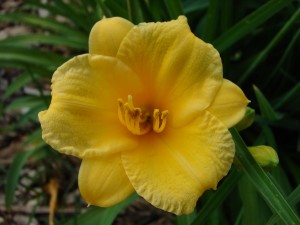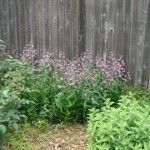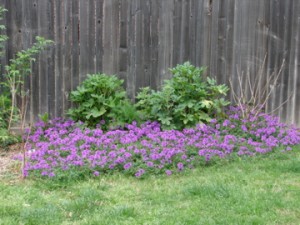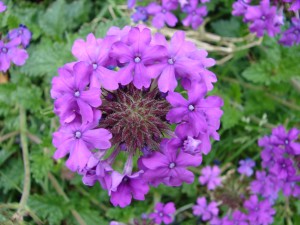May
15

Royal Tapestry Yarrow
Yarrow (Achillea spp.) is an upright lacy perennial with flat-topped clusters that is originally from Europe. Everything I have seen says to plant it in full sun, but I just moved mine to bright shade because it looked like it was getting a little burnt. We will see if that does it.
Yarrow is very easy to grow and will spread quite a bit. It likes well drained soil and is very drought tolerant. It blooms roughly from May to June and needs to be cut back after it’s done blooming.
This variety grows to about 2 feet tall in my garden. It can tend to sort of flop over and would probably benefit from being staked. Soon.
-- Weather When Posted --
- Temperature: 87°F;
- Humidity: 47%;
- Heat Index: 88°F;
- Wind Chill: 87°F;
- Pressure: 29.87 in.;
May
13

Yellow Daylily
I love daylilies! They have got to be one of the easiest flowers to grow in Texas. The daylily (Hemerocallis) is a tuberous root perennial. The leaves look sort of like grass and the flowers bloom from late spring until fall. Daylilies are incredibly disease resistant and they are drought tolerant, but they will multiply more with regular water and fertilizer. DON’T overwater in the heat of the summer, though, or you will just cook them.

Lil Business Daylily
The yellow ones here were given to me by a friend, Rita. They are the first ones to start blooming and stand about a foot tall.
I have some orange daylilies that are taller – about 3 feet, but they don’t start blooming until later. I can’t remember where they came from, but I know I didn’t buy them.
John’s mother sent us some of Mamo Goode’s daylilies (John’s great-grandmother) that have been in the family now for at least 5 generations! A true heirloom plant! I wish I had a picture of them to post. As soon as they start blooming, I will put one up.
I also have a red daylily that I got from another friend, Michelle. It is called “L’il Business.” It’s not blooming yet this year either, but here is a picture from a previous year.
A little known fact… daylily flowers are edible. Remove the stamens from the flowers and add to salads, soups or stir-fry or fill them with cream cheese. They taste a little bit like green beans. (Eat ONLY from plants that you are positive have not been sprayed with insecticides!)
The daylily comes in almost every color imaginable (except true blue). If you would like to find specific varieties of daylily that do well in our area, you can contact the The Daylily Growers of Dallas (I think they used to be called the Dallas Hemerocallis Society).
-- Weather When Posted --
- Temperature: 89°F;
- Humidity: 51%;
- Heat Index: 93°F;
- Wind Chill: 89°F;
- Pressure: 29.72 in.;
May
06

Elderberry Blossoms

Elderberry Bush
Who knew that the elderberry was such a pretty plant? The bush is about 12 feet tall and has gorgeous blossoms on it. It is actually considered to be an herb with numerous superstitions surrounding it.
In the Middle Ages, legend says that the tree was home to witches, and that cutting down one would bring on the wrath of those living in the branches.
The Russians and the English believe that the trees ward off evil spirits and it was considered good luck to plant a tree near your home. Sicilians think that sticks of the wood can kill serpents and drive away thieves.
Egyptians discovered that applying its flowers improved the complexion and healed burns. Many early Indian tribes used it in teas and other beverages. The British frequently drank home made wine and cordials that was thought to prolong life and cure the common cold. – The Herbal Information Center
Our elderberry has just started blooming for this season. In the fall, it will have tiny black berries where each little flower had been.
The reason we planted ours was not for the beauty or the berries. Supposedly, elderberries produce a lot of humus in the soil and the area we planted it in needed all the help it could get. It was hard packed clay there and would flood every spring.
The elderberry is also great for attracting all sorts of wildlife. We have seen lots lizards and birds call it home.
I have never been able to figure out how to use the berries. I need to make it a mission to find a good recipe for elderberries this year and give it a try. But if we don’t eat them, the birds certainly will!
May
05

St. John's Wort
Perennials are so easy to multiply! Most can be started with a stem cutting.
Plants can either reproduce sexually (by seed) or asexually (by cutting). With asexual reproduction, you are always going to get exactly the same plant from the cutting as the parent plant. That doesn’t always happen with sexual production where cross-pollination can give you something very different.
It’s best to take cuttings in the spring or fall when the weather is more congenial. Working early or late in the day or on a cloudy day is helpful also.
You need about a 3 or 4 inch piece of stem that has not flowered. This can be a mid-section of stem as well as the tip. Cut the stem off just below a leaf and remove the leaves from the bottom portion of the stem. Dip the bottom of the stem in rooting hormone and then stick it into a well draining organic potting mixture (beware of the kinds that have fertilizers added – it can be too much for them while they are trying to develop roots). Keep the soil well watered (damp, not dripping) and keep it in a well shaded area. You can test your rooting in a couple of weeks by giving the stem a gentle tug. If there is resistance, it has rooted.
Once your cutting has a well developed root system, you can transplant it into your garden. Be sure to introduce sun loving plants back out into the sunshine slowly, though, or they will end up with a nasty sunburn.
If you are rooting in the fall especially, don’t give up on a cutting that looks dead. It may just be dormant. Give it till the spring the make a comeback. I have had roses do this even when none of my other roses went dormant at all.
Some of the plants that I have propagated by cutting include a lot of roses, coral honeysuckle, buddleia, Texas coral sage, forsythia, St. John’s Wort, Elderberry, pomegranate, Russian sage, and rosemary. Go ahead and give it a try? It beats spending a ton of money at the garden centers!
Apr
30

Fragrant Pairie Phlox
Fragrance, beauty and drought tolerance… what more could you want in a flower?
Prairie phlox (Phlox pilosa) is a native Texas perenial that does well in part sun or bright shade. The smell is intoxicating and it is a butterfly manget! It has a heady bloom in the late spring and then goes partiallyl dormant for summer and fall. It stands about a foot tall. We have it blanketing the ground underneath the weeping peach trees right near a garden bench. Heaven!
Apr
27

Louisiana Iris
Louisiana Irises are actually a collection of beardless water irises that encompasses five species: Iris hexagona, Iris fulva, Iris brevicaulis, Iris giganticaerulea, Iris nelsonii. They are found naturally in most southern states and even as far north as Ohio. I don’t know exactly which species this is, but I suspect it is the Iris hexagona, which are also natives to Texas. I was given my by another garden friend.
The are that I have my iris in doesn’t stand in water like it used to but they seem to be thriving. They are already blooming and gorgeous this year. I have them in partial shad, but that is probably what is helping them make it through the dry heat of the summer. I will probably need to divide mine this year once they are done blooming.
To learn more about Louisiana Iris, you can check out The History of Louisiana Iris.
Apr
20

Passionflower side view

Passionflower bloom top view
The Passionflower has to be one of the coolest flowers I know. It reminds me of a little flower space ship. It also happens to be a Texas native so it loves it here in my yard.
The Passionflower (passiflora incarnata) has many wonderful qualities, one of which is that it is the host plant for the Gulf Fritillary butterfly. The plant also produces a fruit that can be used to jams, jellies and drinks.
My passionflower was given to me by a friend. Thank you, Michelle! It has been in my garden for four years now and is extremely well behaved although I have another friend that says hers has gotten away from her. It will spread, so you will have to keep up with it if you don’t want it to spread.
We had our first bloom of the season this week. Come on butterflies!
Apr
19
-

-
Stand of Gulf Coast Penstemon
-

-
Gulf Coast Penstemon
This is the Gulf Coast Penstemon or sometimes called the Brazos Penstemon. The scientific name is Penstemon tenuis. It is a Texas native from the marsh areas. It does well in standing water and poorly drained soils, but I have also found it to be very drought tolerant. It is in a part of the yard that used to flood every year and has done quite well with that seasonal flooding where a lot of other plants wouldn’t have made it. I have it in partial shade, but I’m told that it can tolerate full sun.
These pictures were taken just a couple of days ago. The penstemon will bloom again in the fall and then die back to the ground through the winter and go dormant. They will also spread by seed if you want more but it hasn’t been very aggressive about it in my yard. If you don’t want it spreading, just cut the blooms when they are done. It attracts bees (this is a good thing), butterflies and hummingbirds!
Thanks for this one, Teresa. I love it!
Apr
15

Trailing Verbena ('Homestead')

Trailing Verbena
This is a Purple “Homestead’ Verbena that I got from another gardening friend. It is the showiest thing in my garden from about the middle of February until the rest of the garden catches up in May or June. The foliage stays green all year here. I’m not sure if it is a Texas native or not. I know that there are a few verbenas that are native here.
Here is a brief description I found at Paghat’s Garden blog about it:
Homestead Purple is an heirloom hybrid that seems to have hybridized by chance in an old Atlanta Georgia garden. It is a cross between Verbena canadensis which is native of the American southeast ranging as far north as Iowa, pollinated by an unknown Verbena that had not survived in the Atlanta garden by the time a trained eye recognized the “otherness” of what was either a chance hybrid or long lost & forgotten cultivar.
The story of its rediscovery has become almost legendary. Alan Armitage is an authority on perennials, & Mike Dirr is an authority on woody shrubs. These two University of Georgia horticultural professors were driving back from a trip to Athens, Georgia, when they did a sudden U-turn to see what the heck was that amazingly colorful flower in an old homestead garden.
They knocked on the door but the woman who lived there only knew she had always had it in her garden. She shared starts with professors Dirr & Armitage, & from those a new popular verbena was introduced to the world.
The fragrant bright purple flowers are considerably larger than most Verbena, & are upon this perennial from May through all of summer right up to Autumn’s first frost or later. In warmer climates than ours blooms can start as early as March.
We have done absolutely nothing to ours other than throw a little organic fertilizer at it whenever we fertilize the lawn and it is a happy as can be. It will slow down in the heat of August and then start up again when the temperatures cool. It is incredibly drought tolerant. It is an absolutely lovely plant.















